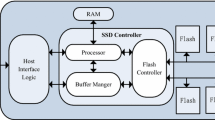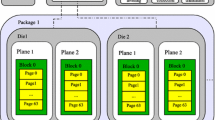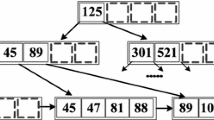Abstract
Solid state disks (SSDs) are becoming one of the mainstream storage devices due to their salient features, such as high read performance and low power consumption. In order to obtain high write performance and extend flash lifespan, SSDs leverage an internal DRAM to buffer frequently rewritten data to reduce the number of program operations upon the flash. However, existing buffer management algorithms demonstrate their blank in leveraging data access features to predict data attributes. In various real-world workloads, most of large sequential write requests are rarely rewritten in near future. Once these write requests occur, many hot data will be evicted from DRAM into flash memory, thus jeopardizing the overall system performance. In order to address this problem, we propose a novel large write data identification scheme, called Prober. This scheme probes large sequential write sequences among the write streams at early stage to prevent them from residing in the buffer. In the meantime, to further release space and reduce waiting time for handling the incoming requests, we temporarily buffer the large data into DRAM when the buffer has free space, and leverage an actively write-back scheme for large sequential write data when the flash array turns into idle state. Experimental results demonstrate that our schemes improve hit ratio of write requests by up to 10%, decrease the average response time by up to 42% and reduce the number of erase operations by up to 11%, compared with the state-of-the-art buffer replacement algorithms.
Similar content being viewed by others
References
Intel Corporation. Understanding the flash translation layer (FTL) specification. Application Note AP-684. 1998
Micron Technology Inc. 64Gb, 128Gb, 256Gb, 512Gb Asynchronous/Synchronous NAND Features. Micron, 2009
Jiang S, Zhang L, Yuan X H, Hu H, Chen Y. S-FTL: an efficient address translation for flash memory by exploiting spatial locality. In: Proceedings of the 27th IEEE Symposium on Mass Storage Systems and Technologies. 2011, 1–12
Gupta A, Kim Y, Urgaonkar B. DFTL: a flash translation layer employing demand-based selective caching of page-level address mappings. In: Proceedings of the International Conference on Architectural Support for Programming Languages and Operating System. 2009
Chang L P. On efficient wear leveling for large-scale flash-memory storage systems. In: Proceedings of the 2007 ACM symposium on Ap plied computing. 2007, 1126–1130
Murugan M, Du D H C. Rejuvenator: a static wear leveling algorithm for NAND flash memory with minimized overhead. In: Proceedings of the 27th IEEE Symposium on Mass Storage Systems and Technologies. 2011, 1–12
Kavalanekar S, Worthington B, Zhang Q, Sharda V. Characterization of storage workload traces from production windows servers. In: Proceedings of IEEE International Symposium on Workload Characterization. 2008, 119–128
Jiang S, Zhang X. LIRS: an efficient low inter-reference recency set replacement policy to improve buffer cache performance. In: Proceedings of ACM SIGMETRICS Conference. 2002, 31–42
Hu Y, Jiang H, Feng D, Tian L, Zhang S, Liu J, Tong W, Qin Y, Wang L. Achieving page-mapping FTL performance at block-mapping FTL cost by hiding address translation. In: proceedings of the 26th IEEE Symposium on Mass Storage Systems and Technologies. 2010
Kim C S. LRFU: a spectrum of policies that subsumes the least recently used and least frequently used policies. IEEE Transactions on Computers, 2001, 50(12): 1352–1361
Zhou Y, Philbin J, Li K. The multi-queue replacement algorithm for second level buffer caches. In: Proceedings of the 2001 USENIX Annual Technical Conference. 2001, 91–104
O’neil E J, O’neil P E, Weikum G, the LRU-K page replacement algorithm for database disk buffering. ACMSIGMOD Record, 1993, 22(2): 297–306
Jo H, Kang J U, Park S Y, Kim J S, Lee J. FAB: flash-aware buffer management policy for portable media players. IEEE Transactions on Consumer Electronics, 2006, 52(2): 485–493
Kim H, Ahn S. BPLRU: a buffer management scheme for improving random writes in flash storage. In: Proceedings of the 6th USENIX Conference on File and Storage Technologies. 2008
Wu G, Eckart B, He X. BPAC: an adaptive write buffer management scheme for flash-based solid state drives. In: Proceedings of the 26th IEEE Symposium on Mass Storage Systems and Technologies. 2010, 1–6
Canim M, Mihaila G A, Bhattacharjee B, Lang C A, Ross K A. Buffered bloom filters on solid state storage. In: Proceedings of VLDB ADMS Workshop. 2010
Park S Y, Jung D, Kang J U,Kim J S, Lee J. CFLRU: a replacement algorithm for flash memory. In: Proceedings of the 2006 ACM International Conference on Compilers, Architecture and Synthesis for Embedded Systems. 2006, 234–241
Jung H, Shim H, Park S, Kang S, Cha J. LRU-WSR: integration of LRU and writes sequence reordering for flash memory. IEEE Transactions on Consumer Electronics, 2008, 54(3): 1215–1223
Li Z, Jin P, Su X, Cui K, Yue L. CCF-LRU: a new buffer replacement algorithm for flashmemory. IEEE Transactions on Consumer Electronics, 2009, 55(3): 1351–1359
Jin P, Ou Y, Härder T, Li Z. AD-LRU: an efficient buffer replacement algorithm for flash-based databases. Data & Knowledge Engineering, 2012, 72: 83–102
On S T, Li Y, He B, Wu M, Luo Q, Xu J. FD-buffer: a buffer manager for databases on flash disks. In: Proceedings of the 19th ACM International Conference on Information and Knowledge Management. 2010, 1297–1300
Lv Y, Cui B, He B, Chen X, Operation-aware buffer management in flash-based systems. In: Proceedings of the 2011 ACM SIGMOD International Conference on Management of data. 2011, 13–24
Canim M, Mihaila G A, Bhattacharjee B, Ross K A, Lang C A. SSD bufferpool extensions for database systems. Proceedingsof the VLDB Endowment, 2010, 3(1–2): 1435–1446
Stuecheli J, Kaseridis D, Daly D, Hunter H C, John L K. The virtual write queue: coordinating dram and last-level cache policies. ACM SIGARCH Computer Architecture News, 2010, 38(3): 72–82
Lee H H S, Tyson G S, Farrens M K. Eager writeback — a technique for improving bandwidth utilization. In: Proceedings of the 33rd Annual ACM/IEEE International Symposium onMicroarchitecture. 2000, 11–21
Author information
Authors and Affiliations
Corresponding author
Additional information
Jingning Liu received the BE degree in computer science and technology from the Huazhong University of Science and Technology (HUST), China in 1982. She is a professor in the HUST and engaged in researching and teaching of computer system architecture. She has over 20 publications in journals and international conferences. Her research interests include computer storage network system, high-speed interface and channel technology, embedded system and FPGA design.
Fangting Huang received the BE degree in software engineering from the Sun Yet-sen university, China in 2010. She is currently working toward the PhD degree in computer architecture from the Huazhong University of Science and Technology, China. She publishes several papers in major conferences including IPDPS, etc. Her research interest includes computer architecture and storage systems.
Yu Chen received the BE degree in computer science and technology from the Huazhong University of Science and Technology (HUST), China in 2013. She is currently working toward the PhD degree in computer architecture from HUST. She publishes several papers in major conferences including DATE, etc. Her research interest includes software-defined storage.
Shuangwu Zhang received the BE degree in computer science and technology from the Huazhong University of Science and Technology (HUST), China in 2012. He is currently a master student in HUST. His research interest includes computer architecture and storage systems.
Electronic supplementary material
Rights and permissions
About this article
Cite this article
Zhou, W., Feng, D., Hua, Y. et al. Prober: exploiting sequential characteristics in buffer for improving SSDs write performance. Front. Comput. Sci. 10, 951–964 (2016). https://doi.org/10.1007/s11704-016-5286-z
Received:
Accepted:
Published:
Issue Date:
DOI: https://doi.org/10.1007/s11704-016-5286-z




